Social and economic development. Рубрика в журнале - Economic and Social Changes: Facts, Trends, Forecast
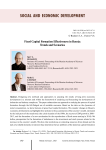
Fixed capital formation effectiveness in Russia: trends and scenarios
Статья научная
Designing new methods and approaches to assessing the results of long-term economic development is a relevant task within the framework of analyzing and forecasting the development of industries and industry complexes. The paper substantiates an approach to studying the process of capital formation through the full-fledged use of available resources. Based on the data on the dynamics of metal consumption, we show features of gross fixed capital formation. We consider changes in Russia's economic development and highlight three periods in the accumulation of the country's wealth, estimated by the indicators of the metal stock (the crisis situation of the 1990s, the recovery GDP growth in 2000-2013, and the formation of a new mechanism for the reproduction of fixed assets starting in 2014). We define prerequisites for the formation of imbalances in the investment and stock process related to the increase in the country's wealth. We show that restrictions on attracting resources from abroad and the lack of a reliable domestic investment base determine the key problems of the domestic capital formation mechanism. We arrange countries of the world in groups according to capital formation indicators, including the availability of resources for capital formation and the availability of favorable conditions for the commercial use of investments. We substantiate the need to increase the effectiveness of capital formation management in Russia. We emphasize that investments in the national investment complex can become effective only if the current criteria for evaluating the effectiveness of economic activity are revised. We provide an overview of the positive and negative scenarios for the development of the domestic capital formation system in the medium term. State management of the investment and stock process is singled out as a necessary element of a positive medium-term forecast
Бесплатно
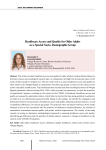
Healthcare Access and Quality for Older Adults as a Special Socio-demographic Group
Статья научная
The article considers healthcare access and quality for older adults in modern Russia. Based on literature sources and sociological research data, we substantiate the high level and special nature of the needs of older people in medical care. The aim of the work is to assess healthcare access and quality for older adults in the Vologda Region in comparison with other age groups, as well as in the context of the private and public health sectors. The information base includes data from sociological surveys of Vologda Region population collected during 2018-2024, which provided an opportunity to track the dynamics of respondents’ opinions, including in the context of the COVID-19 pandemic. Healthcare access and quality are assessed by appropriate indices, which helps to interpret the data using graphical visualization of results in a two-dimensional assessment field. Based on the analysis, we identify the conjugation and dichotomy between the parameters of healthcare access and quality, reflecting common features, as well as significant differences, for various age groups. The practical value and special relevance of the results obtained is due to their correlation with the practices of healthcare commercialization, the division of respondents’ assessments between public and private medical organizations. The novelty of the study consists in testing an alternative methodological approach to assessing healthcare access and quality, identifying age differences and the specifics of elderly patients’ response to changes in healthcare in the context of the COVID-19 pandemic.
Бесплатно
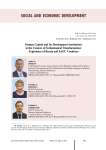
Статья научная
Human capital has been established as one of the central concepts in the system of national development projects in Russia for 2019-2024. The updated national projects have maintained the high relevance of the human capital factor in achieving the goals of economic development in Russia for 2025-2030, but have focused on realizing the potential of each person, developing their talents, and achieving technological leadership. Despite the presence of many publications by Russian and foreign scientists on this topic, which mainly reflect the genesis of the term, its measurement and multilateral assessment, such aspects as changing the content of dominant factors in the context of technologization, digitalization of the knowledge economy in modern society, as well as issues of human capital development through the prism of institutional theory (according to a group of development institutions) are not sufficiently elaborated on. The aim of the study is to identify dominant elements in the context of the technologization of the economy in the matrix of factors affecting human capital, to identify and systematize the most sought-after economic development institutions, as well as to study best practices based on comparative express-analysis using the example of Russia, Belarus, and Kazakhstan. Based on the analysis of modern conceptual approaches to understanding the essence of human capital in the context of the revealed paradigm shift from innovative economic development to technological development, it is concluded that while maintaining the importance of health capital, the knowledge and intellectual component of educational capital comes to the fore, with a predominance of the share of individual talent development (with creative thinking) and its increment by using development institutions at the macro and micro levels. A comparative express-analysis of the development institutions of the Russian Federation, the Republic of Belarus, and the Republic of Kazakhstan has shown that the first type of development institutions meet the needs of the countries' technological development. Among the best practices of the second type of development institutions, such as centers for importing creative behavioral models, personnel training systems with their localization in industry clusters, including competence centers, and corporate employee retraining programs tailored to the demands of the digital economy have been identified. The application of the identified best practices will accelerate the movement of countries toward achieving technological leadership
Бесплатно
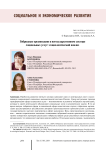
Hybrid organizations in the non-governmental sector of social services: a sociological analysis
Статья научная
Issues regarding the development of the third sector are among major ones in research on Russia’s modern socio-economic system. Current trends in the transformation of the social services sector include the emergence and development of hybrid organizations whose activity combines social goals and commercial objectives. At the same time, hybrid forms in the social sphere have not been given due attention; Russian authors consider hybrid organizations mainly in relation to the development of public-private partnership in the field of economics. The aim of our research is to analyze theoretical approaches to understanding the hybrid model of organizations and consider specific examples of implementation of hybrid forms among Russian non-governmental organizations, which determines the scientific novelty of the work. Another task is to identify the most successful and innovative practices in the development of hybrid organizations representing the relationship between non-governmental and business structures. To solve it, we analyzed two cases: Penza and Kislovodsk, which represent a cluster of organizations providing services to children and adults with special needs. The results of the study showed that the tendency toward the development of hybrid forms for non-governmental organizations is largely related to the desire to achieve financial security. Currently, there exist other hybrid forms besides publicprivate partnerships and non-governmental organizations founded by large commercial organizations and affiliated with them; there emerge new institutional forms when non-governmental organizations establish commercial enterprises that, as a rule, provide additional services or replicate successful social practices on a commercial basis. Such organizations are intended to ensure financial stability of nongovernmental organizations, since part of the profit goes to support the latter. This process opens up significant opportunities for the development of the non-governmental sector, but requires finding a balance between the commercial and social components of such a partnership. The hybrid format creates new prospects for the third sector, allowing for the diversification of resources through the interaction of non-governmental and commercial structures and building more effective interaction with regional authorities. Further research in this area may be related to analyzing the effectiveness of hybrid forms in comparison with traditional NGOs, as well as studying long-term consequences of hybridization for the development of the third sector.
Бесплатно
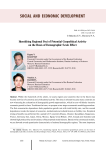
Статья научная
Within the framework of the article, we assess regions and countries that in the future may become new foci of economic and civilizational activity. This issue is relevant because many countries are now witnessing the exhaustion of demographic growth opportunities, which in turn will hinder intensive economic growth in them. To address the issue, we propose a two-stage econometric modeling procedure. The first econometric dependence links population growth rate with total fertility rate, and the second dependence reveals the impact of economic, institutional and cultural factors on fertility rate. Empirical testing of models was performed for a sample of 15 countries (Russia, Ukraine, Kazakhstan, Kyrgyzstan, France, Germany, Iran, Japan, China, Mexico, Egypt, Great Britain, USA, Canada and Australia) and showed high productivity and invariance of the proposed model scheme. Based on the constructed models, we put forward several quantitative characteristics of national demographic regimes. The most important of them is the long-term demographic effect of scale, taking into account the reaction of the population to the growth of per capita welfare. Applied calculations show that the U.S. still has the potential to maintain its growth regime for quite a long time, while China, Japan and Germany have almost exhausted this resource. The most likely foci of a new round of development of human civilization may be Russia, Kazakhstan and Iran, which, taking into account neighboring countries, form a kind of regional cluster in the center of Eurasia. It is in this area of the planet that we should expect the greatest economic and political activity in the next two to three decades.
Бесплатно
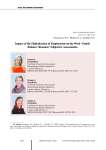
Статья научная
The development of digital technology causes rapid transformation in the sphere of work and the emergence of new forms and formats of employment. The ongoing changes bring to the fore the issue of work-family balance, because it is necessary to promote the well-being of employees with children. The aim of our research is to study the impact of the digitalization of employment on the work-children balance. The empirical base includes findings of a survey of working age women and men, with work experience, living in the territory of the Russian Federation, and raising children under the age of 14 (N = 954); the survey was conducted in May - June 2023. Based on the data obtained, we reveal differences in satisfaction ratings among respondents who intensively use information and communication technologies and do not intensively use/do not use them in their work; the latter have a higher average satisfaction rate concerning the time spent on parental responsibilities. This indicates the ambiguous impact of information and communication technologies on the satisfaction rate regarding the time spent on parenthood. Second, there is no direct relationship between the amount of time parents spend with their children and subjective satisfaction with the time spent on parenthood; this is in line with the results of other studies. Third, we reveal a contradiction between a high assessment of the expected positive effect of a hybrid work format on the time spent on children and low satisfaction regarding the time spent on children in women that work under a hybrid employment scheme. The revealed contradiction indicates difficulties in the practical implementation of this work format, which significantly reduce women’s satisfaction regarding the time spent on parenthood. The determinants of this effect require further verification with the use of qualitative techniques.
Бесплатно
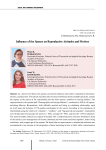
Influence of the spouse on reproductive attitudes and motives
Статья научная
As a micro-level factor, the spouses or partners influence each other’s reproductive intentions, motives, and decisions. This article examines only two areas of influence from a possible spectrum, namely the impact of the nature of the relationship and the other spouse’s position on having children. The empirical basis is the opinion poll “Demographic well-being of Russia”, conducted in 2020 in 10 regions, including Moscow. Respondents, both officially married and being in cohabiting relationship, aged up to 49 years old inclusive (2,776 people) participated in the survey. According to the evaluations of relationships using the criteria of “cohesion”, “conflicts”, and “big quarrels and scandals”, respondents were divided into three groups: the worst (12-16%), average (29-36%), and best (42-53%) evaluations. The most favorable relations are typical of families with a traditional power structure (husband is head of the family), joint management of income (husband and wife make decisions together), better living conditions, and younger age of the spouses. We found that an improvement in relationship estimates was accompanied by an increase in the proportion of those intending to have a child, while a deterioration in the estimates was accompanied by a decrease in the proportion of those intending to have a child. The groups with the most cohesive, conflict-free relationships are the most likely to have children in the coming years, and it increases if new family support measures are introduced. In postponing the birth of children of different order, as well as in planning their birth, the position of the other spouse or partner (the desire to postpone having a child or the intention to have one) is one of the most significant motives of reproductive behavior. The importance of motives is conditioned by both favorable and unfavorable relations in families. The results of the study actualize one of the directions of state socio-demographic and family policy - activities to harmonize marital and family relationships and to reduce the influence of a range of factors complicating these relationships, which can have a positive impact on the decision to have children.
Бесплатно
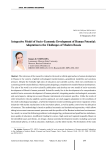
Статья научная
The relevance of the research is related to the need to rethink approaches to human development in Russia in the context of global technological transformations, geopolitical volatility and sanctions pressure. Despite the formally high rates of education and scientific activity, their real contribution to economic growth remains limited, which requires designing a comprehensive model of human development. The aim of the work is to review scientific publications and develop our own model of socio-economic development of Russia's human potential. Scientific novelty lies in the development of a comprehensive model of socio-economic development of human potential, integrating modern technological, economic and social aspects, taking into account Russian institutional environment specifics. Unlike the works of other researchers who also applied a systems approach, our study suggests adaptation to the conditions of the sixth technological paradigm, a hybrid development model combining government regulation of key industries with market mechanisms in the innovation sphere, as well as public control over the allocation of resources. The methodology is based on political economic and institutional approaches, which allows taking into account macroeconomic processes and the specifics of the Russian institutional environment. As a result, we reveal the following problems: technological lag, professional and qualification imbalance, poor quality of education, insufficient funding for science, high social and regional inequality. Based on the identified issues and threats, we design a human potential development model, including social and institutional spheres, as well as education, healthcare, and the labor market. The limitations of the study are related to the need for further elaboration on specific mechanisms for the implementation of the proposed model, including a system of indicators and economic policy measures. The research prospects include an in-depth analysis of regional specifics, as well as the adaptation of international experience to Russian conditions. Practical significance of the work lies in the possibility of using its findings to shape public policy in the field of education, science and social development.
Бесплатно
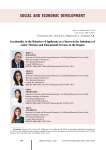
Статья научная
One of the reasons for the imbalance of labor markets and educational services is that applicants choose the universities and the specialties that are unclaimed in the present and future labor market. The article presents the results of an empirical study on identifying behavioral patterns of applicants when choosing a direction of study and higher education institution (2021, N = 4228), which was conducted among 10th and 11th graders of the Republic of Bashkortostan. We considered the results of the survey broken down by three territorial blocks: the capital (urban district of Ufa); urban area - 8 urban districts; rural area - 54 municipal districts. The analysis revealed three irrational patterns of behavior among applicants: 1) choosing “easy” humanities and economic specialties as the subject of the Unified State Exam (USE), not allowing to enter the desired in-demand specialty; 2) desire to enter a “promising specialty” not related to the choice of the USE; 3) applying for specialties not related to the choice of the USE subject and the desire of the entrant. During the study we found that the irrationality of an applicant’s behavior in a difficult situation associated with the multiparameter choice of training program and higher education organization becomes one of the causes of imbalance in the labor and educational services market in the region. We determined that further research on the behavior of applicants should be conducted in the following directions: modeling and forecasting behavior of applicants (development of a comprehensive agent-based model of the educational system of the region, allowing for computational experiments to assess the impact of various mechanisms of state influence on the behavior of agents (applicants), and the development of practice-oriented and interactive methods of vocational guidance among school students, especially in rural areas.
Бесплатно
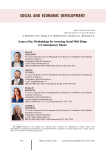
Issues of the methodology for assessing social well-being in contemporary Russia
Статья научная
The article provides a critical analysis and synthesis of modern concepts of social well-being, as well as decomposition and operationalization of this sociological concept, which allows solving the problem of measuring and assessing the quality of life of individuals and social groups in a more comprehensive way. We have shown differences in the understanding of social well-being as a socio-psychological construct based on an individual’s subjective evaluation of the conditions and results of their life activities, and as an objective assessment of the social and economic status of the individual, their involvement in social networks, access to public goods. We also noted that when choosing a methodology for measuring social well-being, it is necessary to consider the economy of the society under consideration (developed or developing) and the existence conditions of the local community as a whole, not just individuals (the concept of community well-being). Based on a synthesis of existing approaches, methodologies, and sets of variables for the empirical study of social well-being, we propose our own version of the methodology for the comprehensive measurement of social well-being, which takes into account the specifics of social processes and relations in contemporary Russia. Within the framework of this methodology, we identify 11 basic factors affecting the level of social well-being, operationalized through more than 50 indicators. The sources of data for their measurement, along with state and corporate statistics, are mass sample and expert surveys. In the article we also raise the problem of calculating weighting coefficients for various factors contributing to social well-being, and proposed its solution on the basis of the ranking method as a special case of the expert evaluation method. The considered set of factors allows covering economic, social, political and legal, medical, socio-cultural and everyday components of life of individuals and local communities.
Бесплатно
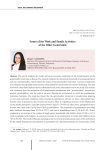
Issues of the work and family activities of the older generation
Статья научная
The article analyzes the trends and socio-economic conditions of the transformation of the grandmother institution in Russia. The research employs the theoretical framework of neoclassical theory and neo-institutionalism, which explain the nature of the grandmother institution. A system of indicators describing the demographic characteristics of the population and its behavior has been developed. The data from the Federal State Statistics Service (Rosstat) served as the information base for the study. The analysis was conducted from the perspective of all participants: grandparents (the “grandmothers” themselves), parents, grandchildren, and the state as an actor shaping the environment in which the grandmother institution functions. The study has shown that the grandmother institution is transforming, adapting to new socio-economic conditions while retaining its significance. On the one hand, older people have become more in demand in the economy and society. There is a significant increase in the employment of the elderly population, especially among women aged 55–59. On the other hand, grandparents have become even more active in the lives of their grandchildren. The proportion of grandmothers providing daily childcare increased from 22.2% to 32.2%, and that of grandfathers from 13.2% to 23.4%. This is explained by an increase in the number of single-parent households with children (from 13.0% to 21.1% of all households with children), as well as an increase in the employment of women with children (from 76% to 82.8%). The results of Russian sociological surveys reveal the institutional nature of the motivation for the elderly population's participation in grandchild care. Sacrificial attitudes are characteristic of the majority of respondents; however, this position is not supported by parents, who prefer to raise their children independently and turn to grandparents only when assistance is required
Бесплатно
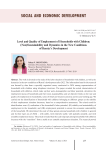
Статья научная
The work is devoted to the study of the labor situation of households with children, as well as its dynamics in the new conditions of Russia's development after 2022. The information base for the research was formed by data from a specially organized survey conducted in 2024 among representatives of households with children using telephone interviews. The paper revealed the actual characteristics of households with children, which make up their socio-demographic and labor potential, determine the employment status of households and their (non-)sustainability, and set objective limits on the rate and quality of employment in households, some of which are beyond economic activity and working age. We carried out the identification of households with children belonging to different groups as the stability of their employment situation decreases, based on a comprehensive assessment. The criteria used for identification were: (I) realization of the household's labor potential, (II) stability and sustainability of employment in the household, and (III) employment potential to ensure the economic sustainability of the household. We determined the scale of these groups among households with children in general and by their types (as of 2024) – with stable, with relatively stable, with partially unstable, and with unstable employment status. The article revealed that the scale of groups among households with children increases with the “transition” from a stable to an unstable employment situation. The research proved that the prevalence of stable employment status reaches the highest values among households with one child (4.6%), unstable employment status among large households (78.8%)
Бесплатно
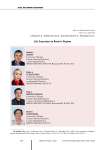
Life expectancy in Russia's regions
Статья научная
Life expectancy at birth is used as a comprehensive indicator of public health and socioeconomic development. The impact of the quality of healthcare, reginal economic development and people’s welfare on life expectancy at birth in Russia requires more detailed and system-wide scientific substantiation at the level of RF constituent entities. The novelty of the study consists in identifying the impact of various factors on the increase in life expectancy by constructing panel vector autoregressions in groups of Russian regions identified with the help of clustering and showing similar rates of increase in life expectancy. The results of the obtained models in the context of the formed clusters demonstrate that the increase in life expectancy in all clusters correlates with the positive dynamics of economic development in the region and the increase in average per capita income. Factors contributing to the organization of the healthcare system in the regional context are poorly related to life expectancy indicators due to the underfunding of this area, orientation toward a decrease in the provision of beds in hospitals due to the optimization of the healthcare system and the cumulative nature of the impact. The conclusions obtained in the course of our study can be used in the practice of managing the quality of life and socio-economic development in Russia’s regions.
Бесплатно
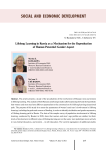
Lifelong learning in Russia as a mechanism for the reproduction of human potential: gender aspect
Статья научная
The article presents a study of the peculiarities of the involvement of Russian men and women in lifelong learning. The analysis of both Russian and foreign studies allowed putting forward the hypothesis that women and men may have different approaches to the construction of a lifelong learning educational path. The purpose of this study is to assess the parameters of women's and men's involvement in lifelong learning, including the goals and sources of funding, in order to identify similarities and gender asymmetry of lifelong learning path in Russia. The data of the sample survey of population involvement in lifelong learning, conducted by Rosstat in 2020, show that women and men's age profiles are similar, but their levels of involvement in different types of lifelong learning are not the same: men participate more actively in non-formal education, and women - in self-education. The current segregation of additional studies for qualification and field generally reflects the existing sectoral and occupational segregation in employment. At the same time, both women and men rarely associate their additional training with the expanded career opportunities, which may indicate the absence of a full-fledged system of vertical professional mobility based on the human potential growth. Our calculations show that employers more often invite men than women to take additional education and, accordingly, women more often than men pay for it themselves. Women with young children experience particular difficulties in participating in non-formal education and more often than others have to pay for themselves. This, in our view, contributes to the formation of gender inequality of opportunities for participation in lifelong learning, which makes it important to consider the gender factor in state programs of lifelong learning development in order to maximize its contribution to the human potential reproduction.
Бесплатно
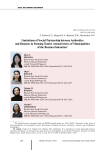
Статья научная
Social partnership between authorities and business is a strategic factor of a territory’s socio-economic development and increase of the level of competitiveness among local tourist products and services. The purpose of the study is to identify the key limitations in the formation of social partnership between government and business in the context of solving the issues of developing the tourist attractiveness of municipalities of the Russian Federation. The authors used general scientific research methods (generalization, systematization, etc.) and analytical procedures based on comparative and system analysis methods. The key method was a questionnaire survey of experts - heads of municipalities (N = 306). The study was conducted in 2019. As a result of the survey, we identified the key problems of implementing social partnership projects in the tourism sector that do not allow local authorities to form sustainable interaction strategies with business: lack of interest among business, unfavorable investment climate, lack of efficient support for projects in mass media, etc. The authors justified the expediency of using municipal property on the principles of the cooperation economy as a tool for the development of social partnership in the tourism area. By summarizing successful practices of business participation in the development of municipal tourism and analyzing the survey results, we developed the areas for improving activities of local authorities to create conditions for the formation of tourist attractiveness based on social partnership (creation of museum and tourist clusters, branding of the territory, active informational support and popularization of tourist destinations in mass media, organization of project offices for tourism development, etc.). The authors conclude that the institutional environment for the development of social partnership in the tourism area is currently at the formation stage. It requires further study.
Бесплатно
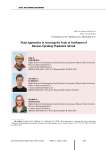
Main approaches to assessing the scale of settlement of Russian-speaking population abroad
Статья научная
Russian diaspora is one of the largest in the world and, according to various sources, includes from 10 to 40 million expatriates. It has been forming since the 18th-19th century during periods of unrest, wars and political change. Natural decline of Russian population, reduction in the migration growth of the population of Russia, and changes in ethnic composition determine the need and relevance of assessing the scale of the country’s repatriation potential. The aim of the work is to analyze existing data sources and approaches to estimating the number of Russian-speaking population and to identify the countries in which it is concentrated, for subsequent assessment of Russia’s repatriation potential. The article presents main approaches to identifying Russian expatriates, estimates the number and describes the geographical distribution of Russian-speaking communities abroad. The interpretations of such widely used concepts as “emigrants”, “diaspora”, “compatriots” and “Russian-speaking communities” are considered in detail and comprehensively, as well as the specifics of their definition and statistical accounting. We use data from the United Nations, national statistical services of various countries, and expert assessments. The data presented emphasize the importance of Russian-speaking communities in the context of globalization and international migration. The article provides statistics on international migration flows from Russia, including an analysis by country of residence and the dynamics of the number of emigrants since 1990. We discuss differences in migration statistics presented in Russian and foreign sources, methods of determining the basis (by place of birth, by ethnic origin), as well as new forms of emigration, including labor emigration and episodic emigration. The analysis of the territorial distribution of Russian-speaking communities shows their geographical diversity with significant presence in Russia’s neighboring countries (Ukraine, Kazakhstan, Uzbekistan) and in other regions, including North America (USA, Canada), Europe (Germany, France, Baltic countries), and the Middle East (Israel, Turkiye, UAE). The findings of our research can be useful in the development of state migration policy and assessment of geopolitical implications of migration processes, including the repatriation potential of the Russian Federation.
Бесплатно
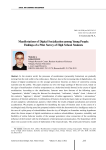
Статья научная
In the modern world, the processes of socialization (personality formation) are gradually moving from the real world to the online space. However, due to the increasing risks of digitalization, the impact of digital socialization on the younger generation becomes an object of controversy among scientists and the public. The paper proposes our own two-stage typology of Internet users, based on the signs of manifestation of online temperament as a behavioral model formed in the course of digital socialization. According to the classification, Internet users have features of the following types: “opportunist / idealist” (using the Internet for deception), “enthusiast / skeptic” (trust / distrust of the content), “aggressor / tolerant” (manifestation of online aggression), “addictive / autonomous” (presence of Internet addiction). Combinations of features of particular types make up the general types of users (adaptive, substitutional, passive), which reflect the results of digital socialization and network acculturation. We propose an algorithm for identifying the types of Internet users in the course of a sociological study. Having tested the proposed solution within the framework of an intelligence study (in the case of a pilot group of schoolchildren from the city of Vologda) we formulate working hypotheses about the diverse impact of digital socialization on modern schoolchildren; dynamics, instability and flexibility of online behavior models of the younger generation; close connection of the socializing influence of the Internet with the development of interpersonal communication. The hypotheses will be taken into account in the course of elaboration of the research topic. The article puts forward a model for organizing digital socialization based on the harmonization of interests of the widest possible range of agents. The findings of the research can be used in the formation of strategic plans for the development of the digital industry and educational policy. Scientific novelty of the research consists in the development of a new methodological solution for using the socializing influence of the Internet environment in the process of generalization.
Бесплатно
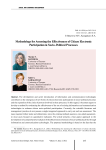
Статья научная
The development and active introduction of information and communication technologies contributes to the emergence of new forms of citizen electronic participation in socio-political processes and the expansion of the circle of persons involved in these processes. In this regard, it becomes urgent to develop a method for evaluating the effectiveness of the use of existing information and communication technologies to enhance citizen socio-political participation. Currently, the scientific literature and management practice do not possess a single integrated approach to carry out such an assessment. The issue requires further study and elaboration, since the existing methods assume a one-sided assessment, in most cases focused on quantitative indicators. The article presents a four-aspect approach to the development of a comprehensive indicator of the effectiveness of citizens of socio-political activity through information and communication technologies. The proposed methodology is based on the fact that the effectiveness of information and communication technologies in increasing socio-political participation is determined by the ability of citizens, involved with their help in socio-political processes to participate in the policy pursued by the authorities, influence it and even determine it. The effectiveness of such socio-political participation depends on four aspects (technical, economic, social and political), each of which is determined by a set of indicators. All these aspects affect the perception of information and communication technologies, used by citizens for the manifestation of socio-political activity, as well as assessing the level of their accessibility, satisfaction with them and trust in them. The methodology was tested as part of a study of the socio-political participation of the Tyumen Oblast citizens using modern technologies. The study will be interesting for government and business representatives involved in the development, implementation, improvement of existing information and communication technologies for the purpose of citizens’ socio-political participation.
Бесплатно
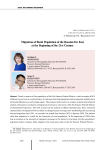
Migration of rural population of the Russian Far East at the beginning of the 21st century
Статья научная
Nearly a quarter of the population of the Far Eastern Federal District, which occupies 40.6% of Russia's area, lives in rural territories. It is obvious that rural population and its migration mobility have territorial differences in such a large region. The purpose of the study is to conduct a spatial and temporal analysis of dynamics and factors of migration processes in rural areas of the Far Eastern Federal District of the Russian Federation. The work is based on the analysis of official statistical data. Since structural characteristics of migration flows are likely to change because of using a new methodology for accounting internal migration since 2011, we consider the period from January 2012 to January 2020. The authors show that migration is crucial for the formation of rural population. At the beginning of 2020, there was an increase in the intensity of migration processes in the district's rural areas, but the population's migration decline remains. Most migrants from rural areas settle in the Far Eastern Federal District - often, in towns. The flow of migrants from the town to the village retains statistical significance but does not correspond to the territorial structure of the migration outflow of rural residents. Based on the ratio of migration and natural population decline (growth), the authors developed a classification of rural areas in the subjects of the Far Eastern Federal District for 2011 and 2019. We analyze the reasons for the arrival and departure of rural population. Most migrants arrive after a temporary absence and leave for personal and family reasons. The authors show the influence of the dynamics of migration processes on the development of rural areas and agriculture in the context of a shortage of labor resources and restrictions on international movements of labor immigrants using a case study of the border region.
Бесплатно
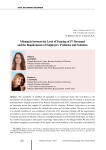
Статья научная
The availability of qualified IT specialists is an important factor that contributes to the development of the digital economy. The need for personnel training for the IT industry is stated in the national project “Digital economy of the Russian Federation until 2024”. Educational organizations are an important source that supplies IT specialists for the economy. However, today there is an acute problem of inconsistency between the educational system and the labor market. The aim of the study is to identify problems of non-compliance of the level of IT personnel training with the requirements of employers, and to determine ways to address these problems (on the example of the Vologda Oblast). Using the data from the Ministry of Science and Higher Education of the Russian Federation, we analyze the number of graduates in information technology-related fields in the Vologda Oblast. We also review educational programs at universities of the region and reveal problems in the formation of professional competencies in students. Based on the results of a survey conducted in 2020 by VolRC RAS, we have obtained information on the compliance of the level of competencies in graduates of IT specialties with the requirements of employers in the IT industry. In the final part of the article we highlight problems related to personnel training for the IT industry of the region and outline main ways to address them. Scientific novelty of our work consists in the application of a system-wide approach that help us study the viewpoints widespread in the education system and among employers, in order to identify problems related to the training of in-demand personnel for the IT industry. The materials of our study can be used by researchers, postgraduates and students who deal with the issues of digital economy development and those related to the staffing of this industry. Practical significance of our work lies in the fact that our proposals for solving the problems under consideration can be used by federal and regional authorities and management bodies, when it would be necessary to adjust plans for the implementation of national projects “Digital economy” and “Education”; our proposals should also be the basis for goal-setting and reflected in the tasks of other regulatory documents in the field of education at the federal and regional levels.
Бесплатно

